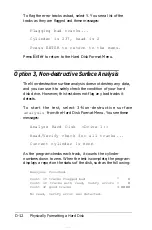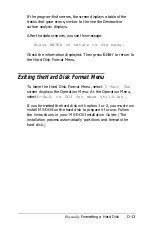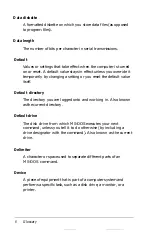
Command
An instruction you enter (usually on a keyboard) to direct your
computer to perform a specific function.
Command prompt
The symbol or message that tells you MS-DOS is loaded and
ready to receive instructions. The default command prompt
displays the current drive and directory. If you are logged onto
drive A, the command prompt looks like this: A>.
Configuration
The particular setup of a group of components. For example, a
typical system configuration consists of a computer with one
diskette drive and one hard disk drive and a monitor, connected
to a printer.
Control code
A command (generated when you hold down
Ctrl
and press
another key on the keyboard) that instructs the computer to
perform a specific function.
Conventional memory
The memory on the main system board (up to 640KB) used by
MS-DOS and application programs. Also called base memory or
main memory.
Coprocessor
An optional device that enables the computer to process certain
mathematical calculations faster.
4
Glossary
Summary of Contents for Equity 386SX PLUS
Page 1: ...m u cl3 0 z E 5 J I 1 al y 8 c 7 5 w ii u l X ...
Page 4: ...EPSON E Q U I T Y 3 8 6 S X User s Guide Y19299100100 ...
Page 20: ...6 Introduction ...
Page 38: ...1 18 Setting Up Your System ...
Page 69: ......
Page 70: ...2 32 Running the Setup Program ...
Page 96: ... 7 R _ ri h 14 3 26 Using the Equity 386SX ...
Page 168: ...5 26 dling Options ...
Page 192: ...B 4 Power on Diagnostics ...
Page 232: ...C 40 Performing System Diagnostics ...
Page 246: ... D 14 Physically Formatting a Hard Disk ...
Page 250: ...E 4 Hard Disk Drive Types ...
Page 282: ...8 I n d e x ...
Page 284: ......
















































